|
| To Search This Site Enter Key Words Into Text Field On The Right and Hit The Search Button |
|
|
Dr. Robert D. Ballard.
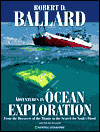 |
Ballard, Dr. Robert D & Malcolm McConnell. Adventures in Ocean Exploration: From the Discovery of the Titanic to the Search for Noah’s Flood. 1st printing. Wash, DC: National Geographic. February, 2001. hardcover. including some color paintings illustrated by Ken Marschall. isbn: 0792279093. scarcity: fairly common.
A continuation of Ballard’s undersea adventures started in the book Explorations. My Quest for Adventure and Discovery Under the Sea. This book is in a large, coffee table sized format, profusely illustrated.
Amazon.com lists the hardcover isbn# as 0792279093 (which is the isbn number on the copyright page in the book), but Barnes & Noble lists the hardcover isbn# as 0792279921 (this is the isbn number on the dust jacket).
Published simultaneously in softcover by the same publisher, isbn# 0792279085.
|
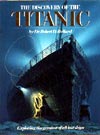 |
Winner of the Titanic Book of the Year Award for 1987.
Ballard, Dr. Robert D & Rick Archbold. Discovery of the Titanic. 1st American printing. NY: Warner Books. 1987. hardcover. color illustrated by Ken Marschall. isbn: 0446513857. scarcity: common.
Probably one of the most important works on the Titanic to be published in the last 40 years. The wreck was discovered by Dr. Bob Ballard and Jean-Louis Michel, leaders of the joint American and French expedition. They succeeded where others had failed by doggedly following a numbing, but exhaustively complete, search pattern. This book is the story of that search and discovery.
Day after day for weeks the French ship Le Suroit covered the majority of the search area with their side scanning sonar technology. Because of this massive effort, the area left to check when the American ship Knorr took over was quite small. Dr. Ballard used his novel deep sea photography rig to finish the job, a system that has since become synonymous with deep sea research.
This book actually covers two dives to the wreck, the initial September, 1985 expedition which found Titanic and the follow-up exploratory dive in the summer of 1986. Dr. Ballard’s narrative is always interesting as he interweaves the story of the Titanic with the story of the expedition’s search.
One of the real strengths of the book is the haunting photographs of the once proud ship now rusting quietly on the bottom. The text is full of impressive photos and includes two fold-out plates as well. No Titanic buff’s library would be complete without this book.
|
| Ballard, Dr. Robert D & Rick Archbold. Discovery of the Titanic. 1st British printing. Lon: Hodder & Stoughton. 1987. hardcover. color illustrated by Ken Marschall. isbn: . scarcity: fairly common. This first British edition published simultaneously with the American edition. |
| Ballard, Dr. Robert D & Rick Archbold. Discovery of the Titanic. 1st Canadian printing. Toronto: Madison Press. 1987. hardcover. color illustrated by Ken Marschall. isbn: . scarcity: hard to find. This first Canadian edition published simultaneously with the American and British versions. |
| Ballard, Dr. Robert D & Rick Archbold. Discovery of the Titanic. new edition. NY: Warner Books. 1998. hardcover. color illustrated by Ken Marschall. isbn: 0446513857. scarcity: common. The updated edition of Ballard’s original book. |
|
Ballard, Dr. Robert D & Will Hively. The Eternal Darkness. A Personal History of Deep Sea Exploration. 1st printing. Princeton: Princeton University Press. 2000. hardcover. isbn: 0691027404. scarcity: common.
A history of deep sea exploration from Ballard’s personal point of view, interspersed with the discoveries he has made over the years. There are scattered refereces to Titanic. With thanks to Dru Schillow for this one.
Also available in softcover, same publisher and year, isbn# 069109554X. There was an additional softcover edition in 2002.
|
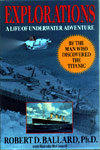 |
Ballard, Dr. Robert D & Malcolm McConnell. Explorations. A Life of Underwater Adventure. 1st paperback printing. NY: Hyperion. April, 1998. wraps. isbn: 0786883898. scarcity: common. A softbound reprint of the following book with a slightly different title. |
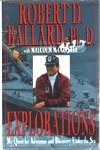 |
Ballard, Dr. Robert D & Malcolm McConnell. Explorations. My Quest for Adventure and Discovery Under the Sea. 1st printing. NY: Hyperion. 1995. hardcover. isbn: 0786860421. scarcity: common.
Published in Great Britain simultaneously by Weidenfeld & Nicolson, hardback, isbn#0297815040.
Also available in softcover.
|
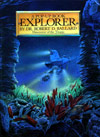 |
Ballard, Dr. Robert D. Explorer: a Pop-Up Book. 1st printing. Atlanta: Turner Publishing, Inc. 1992. hardcover. three dimensional pop-ups, lift-ups and dials. illustrated by James Dietz. children’s book. isbn: 1878685082. scarcity: fairly common.
A pop-up book with pop-up sections describing six of Ballard’s various expeditions, including (in chronoligical order) Project Famous, Cayman Trough, Oases of Life, NR-1, Titanic and the Jason Project.
|
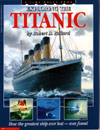 |
Ballard, Dr. Robert D & edited by Patrick Crean. Exploring the Titanic. 1st American printing. NY: Scholastic. 1988. hardcover. color illustrated by Ken Marschall. children’s book. isbn: . scarcity: fairly common. Also available in softcover simultaneously with the hardback version. |
Ballard, Dr. Robert D & edited by Patrick Crean. Exploring the Titanic. 1st British printing. Lon: Pyramid Books. 1988. hardcover. color illustrated by Ken Marschall. children’s book. isbn: 1871307007. scarcity: hard to find.
1st Australian edition, Sydney: Ashton Scholastic. 1989. wraps. isbn# 0590419528.
|
Ballard, Dr. Robert D & edited by Patrick Crean. Exploring the Titanic. reprint. NY: Scholastic. 1997. wraps. color illustrated by Ken Marschall. children’s book. isbn: 0590419528. scarcity: common.
Another hardcover printing by Econo-Clad Books, October, 1999, isbn#0833559141.
|
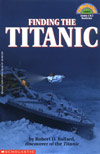 |
Ballard, Dr. Robert D. Finding the Titanic. NY: Cartwheel Books. November, 1993. wraps. color illustrated by Ken Marschall. children’s book. isbn: 0590472305. scarcity: fairly common. |
| Ballard, Dr. Robert D. Finding the Titanic. Econo-Clad Books. October, 1999. hardcover. color illustrated by Ken Marschall. children’s book. isbn: 0785724389. scarcity: fairly common. |
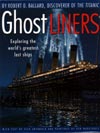 |
Ballard, Dr. Robert D & Rick Archbold. Ghost Liners: Exploring the World’s Greatest Lost Ships. 1st printing. Bos: Little, Brown. 1998. hardcover. color illustrated by Ken Marschall. children’s book. isbn: 0316080209. scarcity: fairly common.
This is a significantly shorter version, written for children, of Ballard’s book Lost Liners.
1st Australian edition, Sydney: Allen & Unwin. isbn# 186448831X.
|
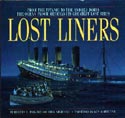 |
Ballard, Dr. Robert D & Rick Archbold. Lost Liners. 1st American printing. NY: Hyperion. November, 1997. hardcover. color illustrated by Ken Marschall. isbn: 0786862963. scarcity: common.
Dr. Ballard’s fascinating dives on the wrecks of some of histories most notable ocean liners, including the Titanic, the Lusitania, the Britannic, and the Andrea Doria.
|
Ballard, Dr. Robert D & Rick Archbold. Lost Liners. 1st British printing. Lon: Hodder & Stoughton. November, 1997. hardcover. color illustrated by Ken Marschall. isbn: 0340696575. scarcity: hard to find. The American & British editions published more or less simultaneously.
1st Australian edition, Sydney: Allen & Unwin, Madison Press, 1997. isbn# 1864484594.
|
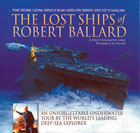 |
Ballard, Dr. Robert D & Ken Marschall. The Lost Ships of Robert Ballard: An Unforgettable Underwater Tour by the World's Leading Deep-Sea Explorer. 1st printing. San Diego: Thunder Bay Press. October, 2005. hardcover. color illustrated by Ken Marschall. isbn: 1592234240. scarcity: common.
In essence this new book can be considered a revised and expanded edition of his earlier book Lost Liners. Much of this book is reprinted from the earlier work, with new chapters on ships he explored after Lost Liners was printed, including the Bismarck, the ships sunk at Guadalcanal and the battle of Midway.
|
|
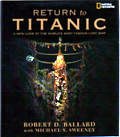
|
Ballard, Dr. Robert D & Michael Sweeney. Return to Titanic. 1st printing. Washington, DC: National Geographic. November, 2004. hardcover. isbn: 0792272889. scarcity: common.
What you get from this book depends a lot on what you expected to get out of it. For the reader with a casual interest in the subject, this will likely be an interesting story of the difficulties involved with exploring the deep ocean. Those of us who study Titanic, and already know a lot about the subject, are going to be more frustrated than enlightened.
Pre-publicity information led us to expect there would be significant photographic comparisons of how the ship has deteriorated since Ballard’s dives in the 1980’s. Images contrasting then versus now are disappointing in their scarcity. Promised details about how quickly the wreck is decaying, and why, also remain essentially unanswered.
In June, 2004, Ballard returned to the Titanic as part of an expedition in collaboration with National Geographic & NOAA (National Oceanic & Atmospheric Administration) to access the current status of the wreck. The group’s purpose was to measure how fast the ship is actually decaying, and what, if anything, can be done about it. Ballard believes a combination of natural forces, and human intrusions are prematurely causing extensive damage that will result in the total collapse of the wreck.
Return to Titanic, the book, is the story of that expedition. Well, sort of. The text certainly covers his visit to the wreck, but Ballard takes two thirds of the book to get there. When he finally does, he attempts to make the case that it is human visits that have done the most damage. Unfortunately, his evidence is weak, and sometimes misleading. Is the damage really a result of human intrusion, or is it a result of natural decay? No definitive answers are forthcoming. Ballard certainly makes accusations, but always hedges his bets by wording his statements in such a way that there is always room for doubt.
For instance, when discussing sections of the handrail on the bow, he grumbles “Either they (the handrails) had lost the fight to degradation, or they had been disturbed by human visitors. All I know for certain was that they had been in place when I saw them last”. About the only fact he can demonstrate is that submersibles visiting the wreck have inadvertently caused damage by bumping into the ship, an almost unavoidable occurrence of working in the utter darkness and unpredictable currents of the deep ocean.
With so little in the text about how much damage the wreck has sustained since his visit in the 1980’s, it is doubly frustrating that there is almost no photographic evidence either. Ballard has stated publicly that hundreds of new images were taken to show how much the ship has changed in the past two decades. Unfortunately, very little of this new imagery made it into the book. If you were expecting lots of photographic comparisons of how the ship looked in the 1980’s versus how it looks now, you are in for a disappointment.
In fact, one thing the reader will notice immediately is that there is an awful lot of uninspired photography. For every two images of the Titanic, there is one of surface ships, or of Ballard himself.
To put the photographic subject matter in perspective there are roughly 50 shots of the Titanic wreck and the debris field in this book. There are 15 shots of the surface ships and the submersibles used to dive to the wreck, and there are about eight of Dr. Ballard, nine if you count the photo of his bloody finger. Did we really need to see a picture of Ballard’s bloody finger?
Why so many shots of surface ships and subs? To answer that question, one needs to understand the real topic of this book. Although called Return to Titanic, that is really the subplot, a substantial subplot to be sure, but still not the real focus of the text. Dr. Ballard is on a mission. He estimates there are more than a million ships of antiquity lost in the deep sea and like the Titanic, these time capsules could provide important information about our history. He states "The greatest museum on earth is beneath the sea and we have the technology to go there. The question is, are we going there to appreciate this history or plunder it?”.
It is an important question, and one worthy of debate. Ballard believes that trophy hunters have, and will continue to plunder, many of these sunken treasure vaults, destroying their archaeological value. He believes that with enough public outcry, the nations of the world could band together and write laws protecting these wrecks. It is a noble goal, but tricky considering that most of these wrecks are in international waters.
He also has strong views on the best method for studying these wrecks, and much of this book is a plug for his underwater video technology as the best tool for the job.
In content, the book is broken down into five chapters. Chapter one begins with a brief recount of the American/French expedition that found the wreck in 1985. Right up front Ballard introduces his deep sea camera technology, which he calls telepresence, and its role in finding the Titanic. After that quick intro, the bulk of the first chapter recounts the Titanic story, its construction, the famous passengers onboard, the maiden voyage and sinking. Anyone who has read more than a handful of books on the subject will find this very familiar territory. The first chapter wraps up with previous attempts to find the wreck that all ended in failure. Ballard finishes with how his underwater camera equipment was first used in what was then secret expeditions funded by the US Navy to photograph the remains of two nuclear submarines lost at sea, the Thresher and the Scorpion.
Chapter two is devoted to pre-2004 dives to Titanic, beginning by going into some detail about Ballard’s 1986 expedition using the submersible Alvin and the remote operated camera sled Jason Jr. He covers later trips by both the French and the Russians, some for sightseeing and others for salvage. Finally he talks about the dives for film purposes, first for the IMAX movie Titanica, and finally James Cameron’s dives to film his documentary Ghosts of the Abyss.
Chapter three detours into a brief history of submersible technology. He talks about William Beebe’s famous dives in the 1930’s. Other advances in deep sea innovations recall Auguste Piccard’s bathyscaph and his more sophisticated submarine, Trieste, one the of first deep submersibles that did not require a direct linkage by cable to a surface support vessel. Oddly, the pioneering work of other famous oceanographers, like Jacques Cousteau, are mostly ignored. Instead Ballard focusses the balance of this chapter on his own archaeological dives around the world, pointing out again the promise of his telepresence equipment, not only in enabling people to remain safely aboard the research ship while the robots do the filming down below, but also the way satellite technology can beam his explorations live to just about any classroom in the world.
In the last two chapters, we finally get into the story of Ballard’s 2004 expedition to Titanic. Despite Ballard’s praise of his new technology, the tale of this expedition is rife with mechanical breakdowns, and technological glitches. Telepresence may indeed be the wave of the future, but it isn’t quite ready for prime time yet. One highlight in chapter four is a double-page map of Titanic canyon, showing in greater detail than ever before the bow and stern sections, and mapping out the debris field. The only downside is that much of the detail is lost in the gutter where the two pages connect. If only this could have been a fold-out plate.
Chapter five continues the story of the 2004 expedition, leading up to the live broadcast from Titanic as seen on the National Geographic television special. There is some discussion of some of the changes they found since the 1986 dives, but with no definite answers as to whether damage is mostly manmade or natural. Finishing the book is a spectacular double-page remake of the 1987 mosaic of the bow section. The clarity and definition of the 2004 version is stunning*.
Even though a lot of the imagery in the book is disappointing, there are some striking new photographs of the wreck, and of items from the ship scattered on the ocean floor. That, plus the map of the debris field, and the remake of the photo mosaic of the bow are definitely the highlights of the book for Titanic buffs. If only there had been more. As it stands, this book is going to be enjoyed the most by individuals who don’t already know a lot about Titanic and her history.
*For an even better view, make sure you pick up the December, 2004 issue of National Geographic magazine, which contains a stunning four part fold-out plate of the bow mosaic.
|
|
|
|
|